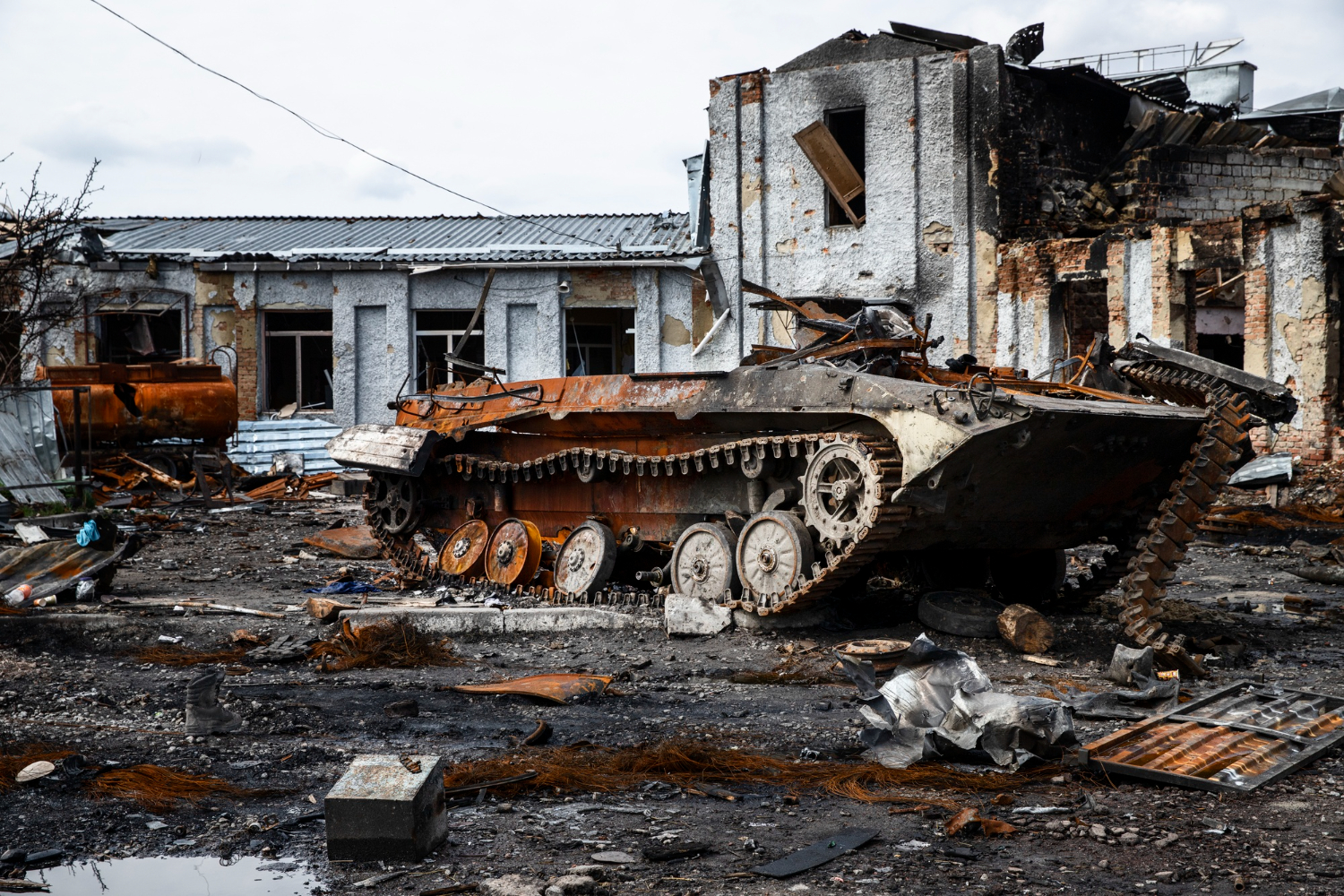The second year of Russia’s full-scale invasion of Ukraine is upon us. Many believe that the end of this conflict is approaching, but the reality may be different – notes Mariusz Marszałkowski, editor at BiznesAlert.pl. The author writes about the defense of Ukraine and the potential for a coup in the Kremlin – is there already a Russian Brutus around Putin?
A difficult year for Ukraine, and an even more difficult one ahead
February 24, 2022 changed a lot in the perception of the security environment in Europe, especially in its central part. Ukraine, despite the Russian superiority on paper, did not fold in the first days of the war, nor did it succumb, even though initially it had to withdraw its military from many areas of the country. The initial successes of the Russians were quickly thwarted thanks to the courage of the Ukrainian soldiers, the public, but also with the extensive support of NATO, both in terms of hardware, equipment and intelligence.
The Ukrainian military staff was well aware of the plans of the Russians and was able to properly prepare defense. Thanks to NATO, the Ukrainians also learned about Russians’ weak points and doubled down on them. The tide has turned quickly thanks to the weapons gifted by the West. The Piorun anti-aircraft systems, which in the first, vulnerable weeks of the war defended the Ukrainian sky, Javelin or NLAW anti-tank systems, which stopped armored and mechanized attacks, later Harpoon missiles, which inflicted losses on the Russian Navy and eventually buried plans for a sea landing on the beaches around Odessa. In the subsequent stages of the war, when Ukraine got stronger and started to repel the Russians, American HIMARS launchers pitched in, and by striking over 70 km beyond the front line successfully pulverized Russian ammunition depots, command posts and areas where troops were concentrated. An example of the successful defeat of the latter type of targets was the New Year’s attack on the technical school building in Makeyevka, where according to official Russian data 63 were killed, and according to unofficial Russian data even more than 200 mobilized soldiers died. Just as many might have sustained injuries.
The western equipment delivered in 2022 also allowed Ukraine to repel Russian missile attacks and swarms of Iranian drones. The Americans provided NASAMS anti-aircraft systems and promised to deliver Patriot systems, Germany gave modern IRIS-T launchers and Cheetah self-propelled artillery kits, the Spaniards provided Aspide and Hawk systems, and the Poles shipped a whole range of anti-aircraft kits of Soviet origin.
Even though the equipment that has already been offered to Ukraine cost a fortune, in order to win Kyiv needs constant supply of spare parts, repair kits, ammunition, rockets as well as propellants, lubricants and fuel. Unlike Russia, Ukraine is constantly under attack by missiles and drones, which hit energy and transmission infrastructure, industrial facilities, refineries and fuel depots. Manufacturing in such conditions is practically impossible. That is why it is so important that the West continues to support Kyiv.
Ukraine’s objectives
After achieving its original goal – maintaining its statehood, Ukraine is now trying to regain control over the areas Russia occupied after 24 February 2022. Russia still controls a large part of Ukraine, including Luhansk, Donetsk, Kherson and Zaporizhia oblasts. Ukraine lost access to the Sea of Azov, Russia at the same time gained a land connection with the Crimean Peninsula.
The latter is Moscow’s greatest and, in fact, only strategic success. Thus, regaining access to the Sea of Azov, and more importantly, cutting the land route connecting Crimea and mainland Russia, may be the main goal of Ukraine in the context of further counteroffensives. The Russians are aware of this, they know that their army is exhausted, largely devoid of modern weaponry, lacking equipment or even ammunition.
This explains Russia’s current tactic, which has one main goal – do whatever it can to divert Ukraine’s attention from Zaporozhye and use „Zeks” (prisoners recruited by the Wagner Group) to relentlessly attack the city of Bakhmut, which is one of the main resistance points before the cities of Slaviansk and Kramatorsk – places that are symbols of the success of Ukraine’s counteroffensive from late spring and summer of 2014. These symbols and Bakhmut itself, which has already joined them thanks to resisting for many months, are in a sense also a trap for Ukraine. Even if, for strategic and tactical reasons, it would be more appropriate to regain, for example, the Zaporozhye Nuclear Power Plant or to cut the corridor to Crimea, from a political and symbolic perspective, it is impossible to give up on Bakhmut. At least, as long as supplies can reach the city and it is not under siege.
This Russian tactic has so far been fairy successful. Instead of amassing forces to retake the south of the country, Ukrainians must send more troops to fill gaps in defense in the Donetsk and Luhansk regions. At the same time, more conscripts are being trained on the territory of Russia, who will be sent to the front in the coming months. It is not clear whether this potential will be strong enough to think about further Russian offensives. However, it will be strong enough to fortify the temporary border on the front line and freeze the conflict for a long time.
The Belarusian bluff
Many analysts assume that Belarus will join the war efforts, and a new attack will be launched from its territory either on Kyiv, just like in February 2022, or in the direction of Volyn, which would cut off Ukraine from western supplies. In my opinion, this attack will not happen for several important reasons.
First of all, the defensive potential of Ukraine in that region is sufficient to withstand the offensive. Even before the invasion in February, the Ukrainians began preparing the northern part of the border for an attack. Anti-tank ditches and trenches were dug, dams were set up, minefields were laid and bridges were mined. Since February, this process has gained momentum, local territorial defense units were formed, and they are being increasingly saturated with modern western equipment, and solid fortifications are being built. An attack on such prepared positions, which are being expanded every week, would end in a massacre for the Belarusian and Russian troops. In that area NATO states would conduct detailed reconnaissance operations, so the aggressors would not be able to hide their intentions and goals.
Second, an offensive from Belarus would legitimize Ukrainian attacks on the country’s bases, airports, and military and energy infrastructure, for instance the Mozyr refinery, one of two in the country, which is located just over 30 km in a straight line from the border with Ukraine. That’s close enough for HIMARS/MLRS GMLRS missiles that have a range of more than 80 km. Fuel from the refinery in Mozyr is used in, among others, Russian tanks and aircraft operating in Belarus, but it’s been also revealed that Belarus sends ready-made fuel to Russian troops also operating in Russia, or in the first phase of the war, to the northern part of Ukraine. The HIMARS/MLRS systems are also capable of reaching Belarusian bases and airports, as well as fuel, lubricant and ammunition depots. Currently, Russia uses Belarusian airports to attack the energy infrastructure of Ukraine with Mig-31BM jets equipped with Kinzhal missiles. Thanks to a „neutral” Belarus, the Russians have an insight into the airspace of central and western Ukraine using the AEW&C A-50U surveillance aircraft, which guides Russian fighters to fight with Ukrainian aircraft that support the troops in eastern Ukraine. Belarus joining the offensive would mean that the Russian army could no longer use this convenient and safe place.
Belarus’s involvement in the war would also entail the loss of a training base for Russian mobilized soldiers, who are trained in safe and comfortable conditions at Belarusian training grounds by the training staff of the Belarusian army. One of Russia’s headaches is the loss of experienced officers who either died during the operations in Ukraine, or simply perform combat missions on its territory. Belarusian officers can prepare the next waves of Russian conscripts to participate in the war.
Another argument for the fact that Belarus will not join the war is the state of the material and equipment base of the Belarusian troops. Since the summer of 2022, there have been signs that the Russians are emptying Belarusian material depots, including equipment, such as tanks. Probably, the Belarusian arms plants are also working at „full steam” in order to provide Russia with access to 122 and 152 mm artillery ammunition. Probably Belarus also still plays the role of a certain open door through which dual-use goods, which formally cannot enter Russia, are imported.
Fourthly, strategically, the goal of an attack from Belarus and with its participation would be to stop the transfer of western arms and equipment to Ukraine. To do this fully, the aggressors would have to go as far as the Slovak-Ukrainian border, and the Ukrainian-Romanian border in the Carpathians, passing or capturing at the same time several large cities such as Lutsk, Lviv, Ivano-Frankivsk, Chernivtsi or Uzhhorod.
Given that the prepared, rested and strong Russian army of February 2022 was not able to capture a SINGLE larger city beyond the months – long siege and complete destruction of Mariupol, and the surrender of Kherson, probably as a result of betrayal, it is hard to believe that it would now be able to capture even larger, better defended and motivated cities in western Ukraine. Bypassing them would also mean a repeat of the February attempt to seize Kyiv, when Ukrainian sabotage groups effectively paralyzed Russian logistics with attacks, which consequently led to the withdrawal of Russian troops from the northern regions of Ukraine. The occupation of such a large area of Ukraine would also require the presence of numerous occupying forces, which the Russians simply do not have.
In addition, even with such a negative turn of events for Ukraine, there is still a connection between Romania and Ukraine through the southern border in the area of Izmail in the Odessa region. NATO support could therefore still flow, although it would be logistically much more difficult and less efficient.
Even without entering the war, Belarus is doing its job as a country freely used by Russians to, among others, launch drones on Kyiv and other Ukrainian cities in central and western part of the country.
In addition, the constant risk of an attack from the north means that a large part of the Ukrainian troops must guard the 1,000 km long border, instead of taking part in active operations in the east or south of Ukraine. This is the most crucial thing for the Russians at the moment, and they are achieving their goal without destabilizing Belarus. And this is actually another argument against Belarus joining the war. Neither the Belarusian command nor the Russian command have any certainty about the morale and will of the Belarusian soldiers to fight. The Armed Forces of Belarus entering the war could cause the opposite effect from the intended one – Belarusians could in large part (more than the Russians) surrender without a fight, sabotage actions, or simply pass information to the Ukrainian side. Instead of a spectacular success in the west of Ukraine, the offensive could end in a strategic failure not only for Moscow, but above all for the Belarusian dictator.
Russia’s goals and the search for Brutus
Russia’s goal may be to exhaust Ukraine as much as possible in order to force it to hold peace talks on Russian terms. The attacks on critical infrastructure and the incessant harassment of Ukrainians with new raids, e.g. in Bakhmut where the Russian troops are digging in and amassing more forces, reveals that the enemy is planning for a long and bloody war. The Kremlin’s Achilles heel is its own policy and arrogant sense of superiority, which has been brutally verified by Ukraine in the past 10 months. Putin and his entourage are aware that they will not retire in Russia, so they cannot lose. As long as the society „stands” behind them, there are no dissenters in the power structures (even though the army is losing influence in favor of the founder of „Wagner” Yevgeny Prigozhin) and the oligarchs are controlled, the Kremlin can continue its war. So far, there are no cracks in this monolith. And Putin’s position on the international arena does not matter here. As long as he and his aides are surrounded by faithful and loyal Praetorians, nothing will change. But even the powerful Julius Caesar got his comeuppance from Marcus Brutus, which ended his life. Is there a Russian Brutus around Putin?









